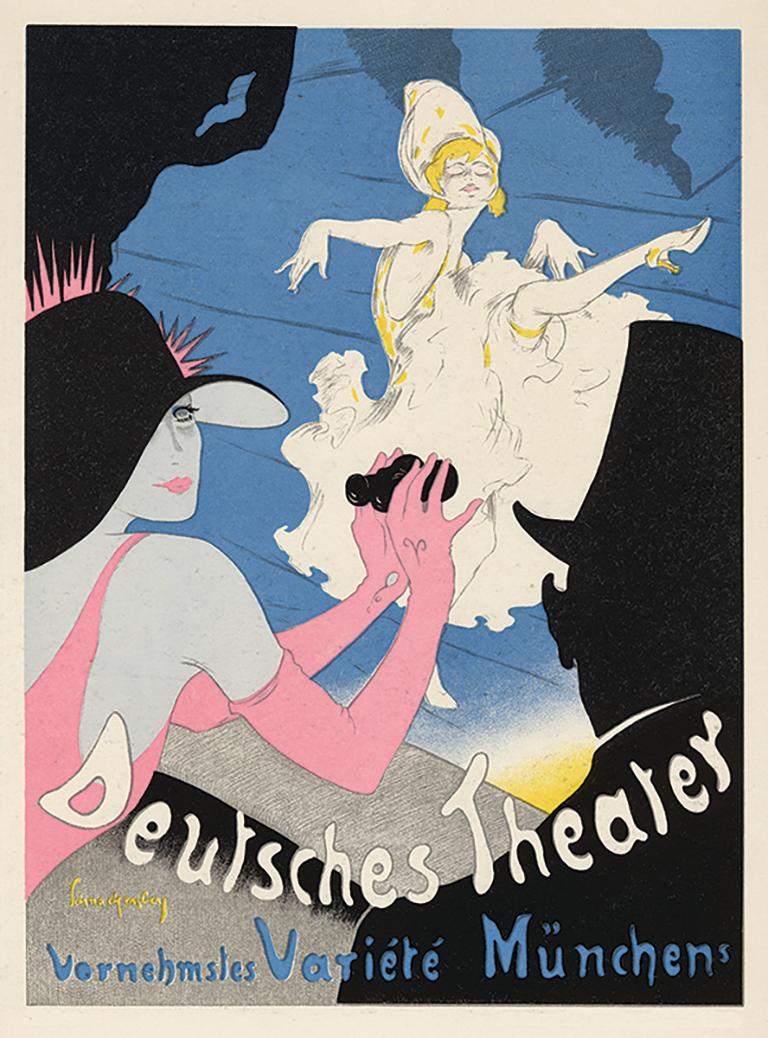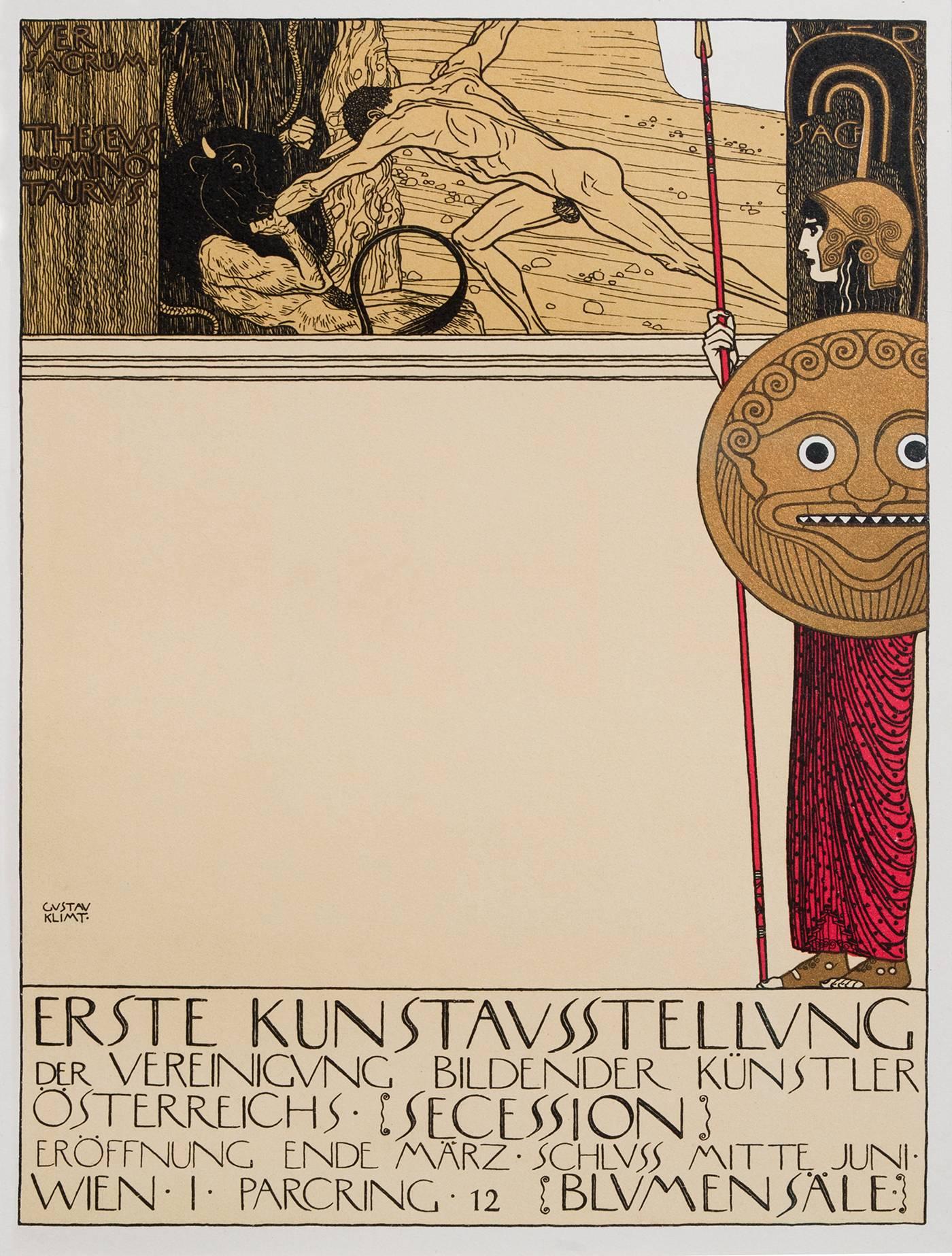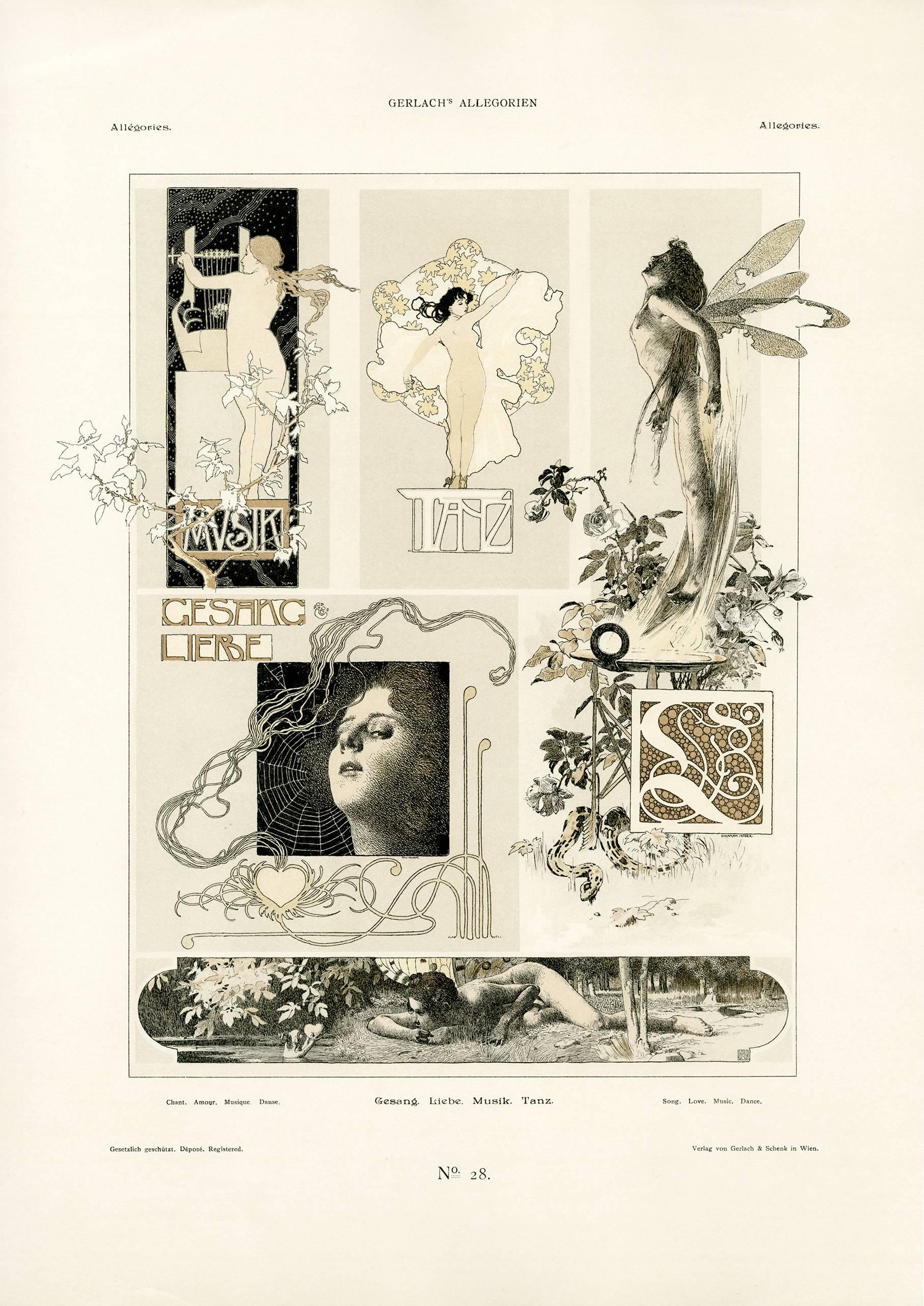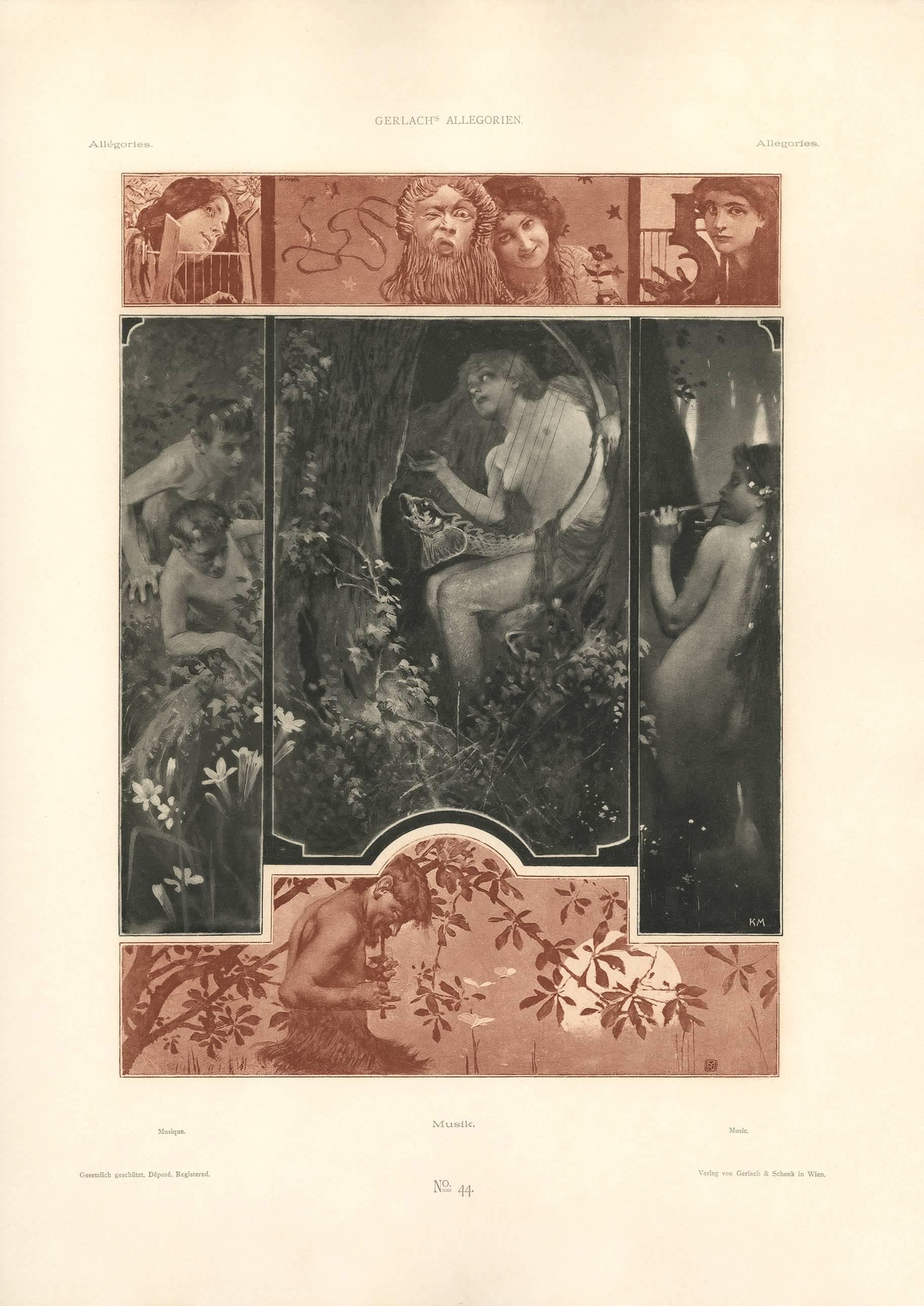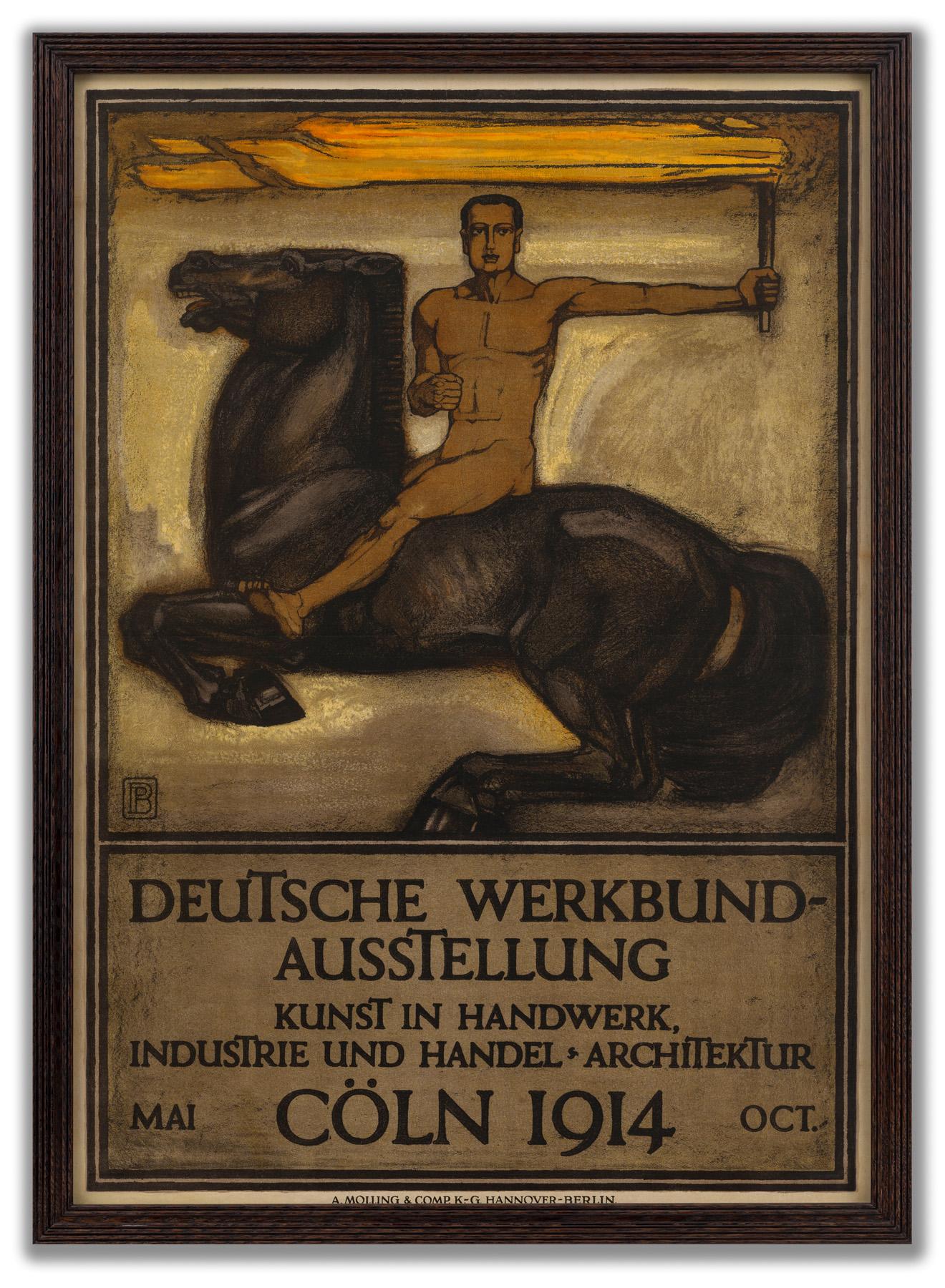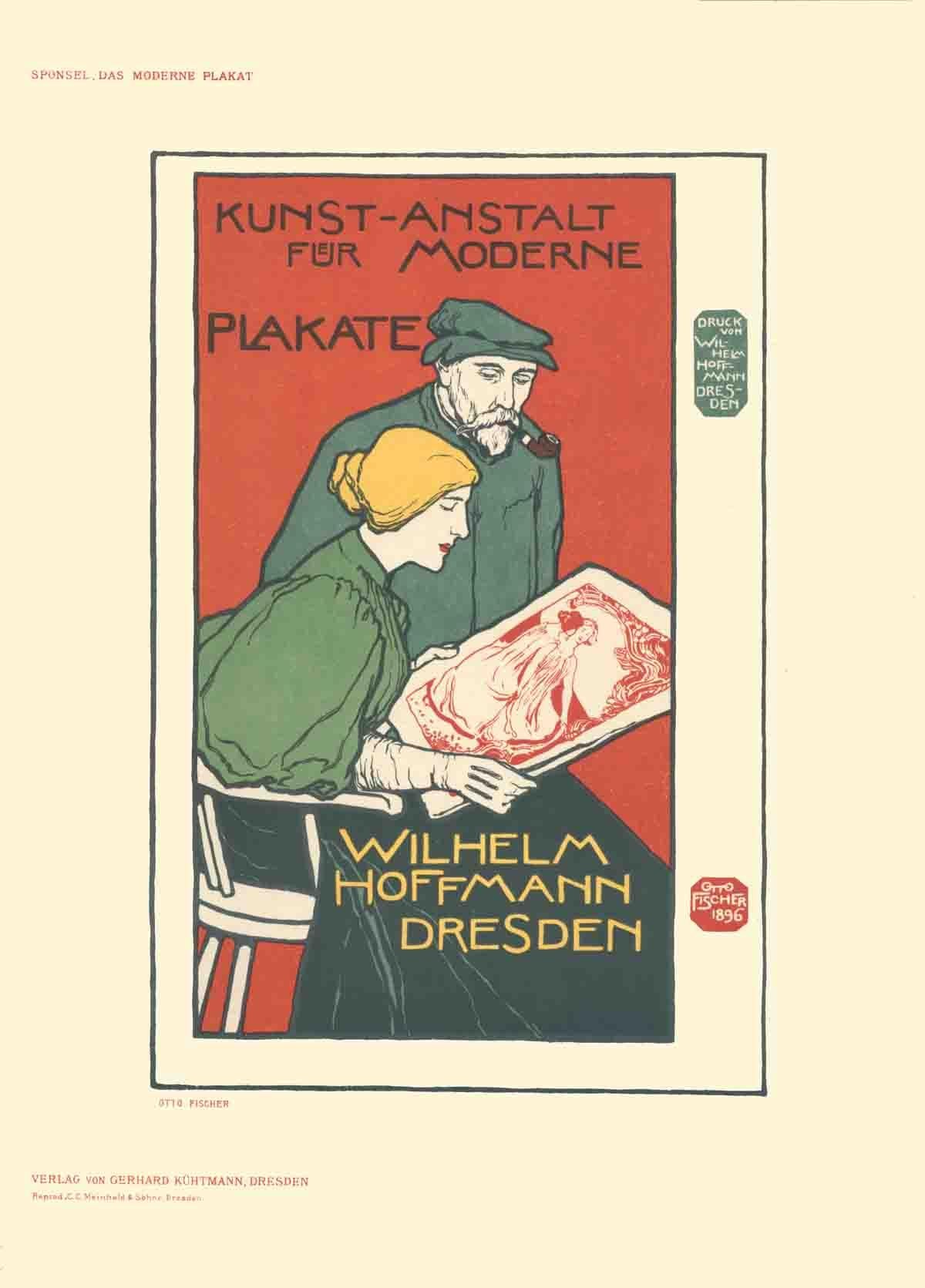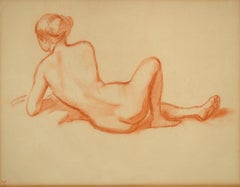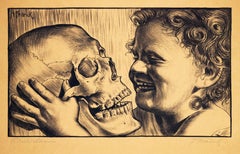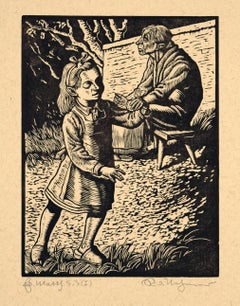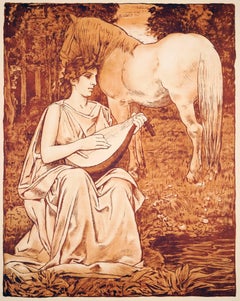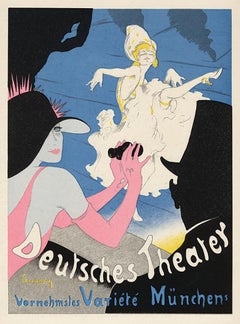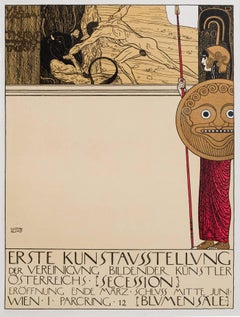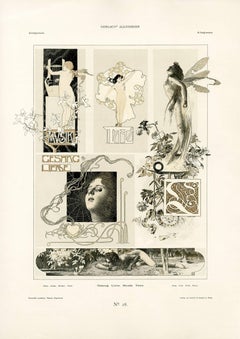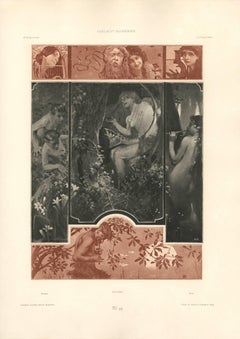Items Similar to Performance by members of the Deutsches Theater zu Berlin / - Ornamental Flow -
Want more images or videos?
Request additional images or videos from the seller
1 of 4
Emil OrlikPerformance by members of the Deutsches Theater zu Berlin / - Ornamental Flow -1899
1899
$207.15
$258.9320% Off
£158.24
£197.8020% Off
€176
€22020% Off
CA$291.88
CA$364.8520% Off
A$321.38
A$401.7320% Off
CHF 166.65
CHF 208.3120% Off
MX$3,806.07
MX$4,757.5920% Off
NOK 2,115.54
NOK 2,644.4220% Off
SEK 1,977.21
SEK 2,471.5120% Off
DKK 1,340.80
DKK 1,67620% Off
About the Item
Emil Orlik (1870 Prague - 1932 Berlin), Ensemble guest performance by members of the Deutsches Theater zu Berlin, 1899. Color lithograph on wove paper, 20 cm x 13.3 cm (image), 29.5 cm x 21 cm (sheet size).
- somewhat darkened, small tears to the outer right margin, slight creases outside the image
- Ornamental Flow -
This graphic is a reduced version of the poster by Emil Orlik for the Deutsches Theater that appeared in the January 1900 issue of the Munich magazine 'Dekorative Kunst'. Still based in Prague, Orlik had become an internationally sought-after Jugendstil artist and was commissioned to design the poster for the Berlin theater's guest performance in Vienna. He combined lettering and figurative representation with flowing ornamentation. The flame of the torch in the theatrical mask is transformed by the flowing ornamental frame into the muse's hair and then into a mask from which the river seems to flow. The orange ornament is enlivened by the complementary color blue, which creates a pattern-like effect that is also reflected in the ornamental letters. Against this background, the poster is a programmatic image of Art Nouveau, which is why it found its way into the prestigious art magazine.
About the artist
Emil Orlik grew up in Prague and studied at Heinrich Knirr's painting school in Munich from 1889 to 1891 and then at the Munich Art Academy from 1891 to 1893. From 1894 to 1896, Orlik returned to Prague, where he did a year of military service and became friends with Reiner Maria Rilke, who inspired him to design books. In 1896 Orlik returned to Munich, where he developed an artistic friendship with Bernhard Pankok. The following year, Orlik opened a studio in Prague, which he ran until 1904. In 1898 he undertook a nearly year-long study trip to England, Scotland, Holland, Belgium and Paris. In 1904, Orlik became a teacher at the Vienna Museum of Decorative Arts. He had been a member of the Vienna Secession since 1899 and published in the Jugendstil magazine 'Ver Sacrum'. In 1905 he was appointed professor at the Berlin Museum of Decorative Arts, where he succeeded Otto Eckmann as head of the graphics class until Eckmann's death in 1932. George Grosz, Hanna Höch and Karl Hubbuch were among his students.
In 1900 Orlik made a year-long trip to Japan, which had a lasting influence on his art. In 1904 he published the portfolio "From Japan" and from 1905 to 1910 he illustrated the six-volume edition of the works of the English diplomat Lafcadio Hearn, who lived in Japan. In 1912 he made his second trip to Japan, which also took him to Egypt, Sudan, Ceylon, China, and Korea. His artistic impressions were reflected in the portfolios "Journey to Egypt" (1921) and "Journey to Japan" (1921). The late 1920s were also marked by numerous trips to America, France, Spain, Italy and Yugoslavia.
In addition to his artistic work as an interior designer, which included designs for costumes and stage sets for Max Reinhardt's Deutsches Theater, Orlik was primarily a graphic artist and sought-after portraitist. He painted portraits of Gerhard Hauptmann, Henrik Ibsen, Bernhard Pankok, Gustav Mahler, Max Klinger, Rainer Maria Rilke, Ernst Barlach, Lovis Corinth, Otto Dix, Käthe Kollwitz, Max Slevogt, Franz Werfel, Rudolf Steiner, Thomas Mann, Albert Einstein, Franz Marc and Alfred Döblin, among others. His virtuosity as a portraitist led Orlik to be hired as a portraitist for the Brest-Litovsk Peace Conference, which resulted in the portfolio "Caricatures from Brest-Litovsk" (1918).
GERMAN VERSION
Emil Orlik (1870 Prag - 1932 Berlin), Ensemble Gastspiel von Mitgliedern des Deutschen Theaters zu Berlin, 1899. Farblithographie auf Velin, 20 cm x 13,3 cm (Darstellung), 29,5 cm x 21 cm (Blattgröße).
- etwas nachgedunkelt, rechts außen kleine Randeinrisse, leichtere Knickspuren außerhalb der Darstellung
- Ornamentaler Fluss -
Bei der Grafik handelt es sich um die verkleinerte Version des von Emil Orlik für das Deutsche Theater angefertigten Plakats, die in der Januarausgabe der Münchener Zeitschrift ‚Dekorative Kunst‘ im Jahr 1900 erschienen ist. Noch in Prag ansässig, war Orlik zu einem international gefragten Jugendstilkünstler geworden, der damit beauftragt wurde, das Plakat für das Gastspiel des Berliner Theaters in Wien zu gestalten. Dabei verbindet er die Schrift und die figürliche Darstellung durch eine fließende Ornamentik. Die Flamme der in der Theatermaske steckenden Fackel verwandelt sich über den fließenden Ornamentrahmen in das Haar der Muse und wird dann zur Maske, welcher der Fluss zu entströmen scheint. Das orange Ornament wird durch die komplementäre Farbe Blau verlebendigt, was einen musterartigen Effekt bewirkt, der sich auch in den ornamental ausgeformten Buchstaben wiederfindet. Vor diesem Hintergrund ist das Plakat ein programmatisches Bild des Jugendstils, das aus diesem Grund Eingang in die renommierte Kunstzeitschrift gefunden hat.
zum Künstler
In Prag aufgewachsen studierte Emil Orlik von 1889 bis 1891 in München an der Malschule von Heinrich Knirr und anschließend, von 1891 bis 1893, an der Münchner Kunstakademie. Von 1894 bis 1896 hielt sich Orlik wieder in Prag auf, leistete dort den einjährigen Militärdienst ab und freundete sich mit Reiner Maria Rilke an, der ihn zur Buchgestaltung inspirierte. 1896 ging Orlik abermals nach München, wo sich eine künstlerische Freundschaft mit Bernhard Pankok entwickelte. Im Folgejahr eröffnete Orlik ein Atelier in Prag, das er bis 1904 führte. 1898 unternahm er eine nahezu einjährige Studienreise nach England, Schottland, Holland, Belgien und Paris. 1904 wurde Orlik Lehrer am Wiener Kunstgewerbemuseum. Er war bereits seit 1899 Mitglied der Wiener Secession und veröffentlichte in der Jugendstilzeitschrift ‚Ver Sacrum‘. 1905 erfolgte der Ruf zum Professor an das Berliner Kunstgewerbemuseum, wo er als Nachfolger Otto Eckmanns bis zu seinem Todesjahr, 1932, die Graphiklasse leitete. Dort gehörten George Grosz, Hanna Höch und Karl Hubbuch zu seinen Schülern.
Im Jahre 1900 unternahm Orlik eine seine Kunst nachhaltig prägende einjährige Japanreise. Anschließend hielt er Vorträge über Japan, gab 1904 das Mappenwerk ‚Aus Japan‘ heraus und illustrierte von 1905 bis 1910 die sechsbändige Werkausgabe des in Japan ansässigen englischen Diplomaten Lafcadio Hearn. 1912 erfolgte die zweite Japanreise, die über Ägypten, Sudan, Ceylon, China und Korea führte. Die künstlerischen Eindrücke schlugen sich in den Mappenwerke ‚Reise nach Ägypten‘ (1921) und ‚Reise nach Japan‘ (1921) nieder. Auch die späten 20er Jahre waren von zahlreichen Reisen nach Amerika, Frankreich, Spanien, Italien und Jugoslawien geprägt.
Neben seiner künstlerischen Tätigkeit als Raumgestalter, zu denen auch Entwürfe für Kostüme und Bühnenbilder für das Deutsche Theater von Max Reinhardt gehören, war Orlik vor allem Grafiker und ein gefragter Porträtist. Er porträtierte unter anderen Gerhard Hauptmann, Henrik Ibsen, Bernhard Pankok, Gustav Mahler, Max Klinger, Rainer Maria Rilke, Ernst Barlach, Lovis Corinth, Otto Dix, Käthe Kollwitz, Max Slevogt, Franz Werfel, Rudolf Steiner, Thomas Mann, Albert Einstein, Franz Marc und Alfred Döblin. Seine Virtuosität als Porträtkünstler führte dazu, dass Orlik als Porträtist für die Friedenskonferenz in Brest-Litowsk engagiert wurde, woraus das Mappenwerk ‚Karikaturen aus Brest-Litowsk‘ (1918) hervorging.
- Creator:Emil Orlik (1870 - 1932, Czech)
- Creation Year:1899
- Dimensions:Height: 11.42 in (29 cm)Width: 8.27 in (21 cm)Depth: 0.4 in (1 cm)
- Medium:
- Movement & Style:
- Period:
- Condition:
- Gallery Location:Berlin, DE
- Reference Number:1stDibs: LU2438216310572

About the Seller
5.0
Vetted Professional Seller
Every seller passes strict standards for authenticity and reliability
Established in 2014
1stDibs seller since 2023
22 sales on 1stDibs
- ShippingRetrieving quote...Shipping from: Berlin, Germany
- Return Policy
More From This Seller
View AllFemale Nude from the Back, around 1900 / - The contour of the Art Nouveau -
By Ludwig von Hofmann
Located in Berlin, DE
Ludwig von Hofmann (1861 Darmstadt - 1945 Pillnitz), Female nude from the back, around 1900. Red chalk drawing on watermarked drawing paper, 36 cm x 44 cm (sheet size). Artist's liga...
Category
Early 1900s Art Nouveau Nude Drawings and Watercolors
Materials
Paper
Death and Life / - United in Laughter -
By Hans Frank
Located in Berlin, DE
Hans Frank (1884 Vienna - 1948 Salzburg), Death and Life, 1911. Lithograph, 18 cm x 31 cm (depiction), 25.5 cm x 38.7 cm (sheet size), signed “H.[ans] Frank” in pencil lower right and inscribed “Tod und Leben” lower left.
- darkened, remains of an old mounting on the verso
- United in Laughter -
Here, Hans Frank refers to the skull as a vanitas motif. In Renaissance and Baroque portraits, this motif symbolizes the transience of the sitter, whose head has become a skull over time. Penitents, such as St. Jerome, often hold skulls in melancholy contemplation. Here, however, the boy stands up for life itself. He boldly grabs the skull and laughs at the absurdity of life and death. The laughter of death joins the laughter of life, and vice versa. The child's thumb penetrates the skull's cheekbone to illustrate the inseparable connection between death and life.
About the artist
Hans Frank studied at the Vienna School of Applied Arts from 1902 to 1906 and then studied painting under Franz Rumpler at the Vienna Academy of Fine Arts from 1907 to 1911. In 1911, he received a substantial travel grant from the emperor, which he used to travel to Switzerland, Paris, London, Belgium, the Netherlands, and Germany. After serving in World War I, Frank moved to St. Marein im Mürztal, returning to Vienna in 1925. He took further study trips to Italy, southern France, and the Austrian countryside. In 1927, Frank became a member of the London Society of Color Printers. An exhibition of his work at the Medici Gallery in London brought him international recognition. He joined the Pasadena Printmakers Society of California and established contacts in Canada. In addition to his highly regarded paintings, Frank primarily worked as a graphic artist. He created over 300 prints and developed a new gradient technique for the fern woodcut with his twin brother, Leo Frank...
Category
1910s Jugendstil Figurative Prints
Materials
Paper
$357 Sale Price
20% Off
Blessed are the spiritually poor / - The Abundance of Poverty -
Located in Berlin, DE
Rudolf Nehmer (1912 Bobersberg - 1983 Dresden), Blessed are the spiritually poor, 1948. Woodcut on yellowish wove paper, 20 cm x 15 cm (image), 45 cm x 30 cm (sheet size), signed “Ru...
Category
1940s Realist Figurative Prints
Materials
Woodcut
$178 Sale Price
20% Off
Muse / - In the realm of the muses -
Located in Berlin, DE
Hans Thoma (1839 Bernau - 1924 Karlsruhe), Muse, 1893. Algraph on strong wove paper, published by Breitkopf und Härtel in Leipzig as ‘Zeitgenössisches Kunstblatt Nr. 174’, 43.5 cm x ...
Category
1890s Realist Figurative Prints
Materials
Paper
$225 Sale Price
20% Off
The Reconciliation / - Togetherness -
Located in Berlin, DE
Rudolf Nehmer (1912 Bobersberg - 1983 Dresden), The Reconciliation, 1948. Woodcut on yellowish wove paper, 20 cm x 15 cm (image), 45 cm x 30 cm (sheet size), signed “Rud.[olf] Nehmer...
Category
1940s Realist Figurative Prints
Materials
Woodcut
$169 Sale Price
20% Off
The fruitless tree / - The End of the Grotesque Era -
Located in Berlin, DE
Rudolf Nehmer (1912 Bobersberg - 1983 Dresden), The fruitless tree, 1948. Woodcut on yellowish wove paper, 15 cm x 14.6 cm (image), 45 cm x 30 cm (sheet size), signed “Rud.[olf] Nehm...
Category
1940s Realist Figurative Prints
Materials
Woodcut
$169 Sale Price
20% Off
You May Also Like
Deutsches Theater by Walter Schnackenberg, German cabaret lithograph, c. 1920
By Walter Schnackenberg
Located in Chicago, IL
Walter Schnackenberg’s most famous image, an extraordinary Toulouse-Lautrec homage promoting theatrical cabaret performance at the Deutsche Theater in Munich. The costume and poster designs of Walter Schnakenberg defined ballet and cabaret during Germany’s Weimar...
Category
1920s Prints and Multiples
Materials
Lithograph
Ottokar Mascha Folio, plate 8: "Poster for the 1st Vienna Secession Exhibition"
By Gustav Klimt
Located in Palm Beach, FL
After GUSTAV KLIMT (1862-1918) THESEUS UND MINOTAURUS, 1898, final design submission for poster advertising the first exhibition of the Vienna Secession, (In Mascha, no. 8) As a cele...
Category
1910s Vienna Secession Figurative Prints
Materials
Lithograph
Gerlach's Allegorien Plate #20: "Song, Love, Music, Dance" Lithograph
By Koloman Moser
Located in Palm Beach, FL
Koloman Moser
(1868 –1918), AUSTRIAN
Instead of applying his flair and art education solely to painting, Koloman Moser embodied the idea of Gesamt Kunstwerk (all-embracing art w...
Category
1890s Vienna Secession Figurative Prints
Materials
Lithograph
Gerlach's Allegorien Plate #44: "Music" Lithograph
By Koloman Moser
Located in Palm Beach, FL
Koloman Moser
(1868 –1918), AUSTRIAN
Instead of applying his flair and art education solely to painting, Koloman Moser embodied the idea of Gesamt Kunstwerk (all-embracing art work) by designing architecture, furniture, jewelry, graphics, and tapestries meant to coordinate every detail of an environment. His work transcended the imitative decorative arts of earlier eras and helped to define Modernism for generations to come. Moser achieved a remarkable balance between intellectual structure (often geometric) and hedonistic luxury.
Collaborating with Gustav Klimt and Josef Hoffmann, the artist was an editor and active contributor to Ver Sacrum, (Sacred Spring), the journal of the Viennese Secession that was so prized for its aesthetics and high quality production that it was considered a work of art. The magazine featured drawings and designs in the Jugendstil style (Youth) along with literary contributions from distinguished writers from across Europe. It quickly disseminated both the spirit and the style of the Secession.
In 1903 Moser and Hoffmann founded and led the Wiener Werkstatte (Viennese Workshop) a collective of artisans that produced elegant decorative arts items, not as industrial prototypes but for the purpose of sale to the public. The plan, as idealistic then as now, was to elevate the lives of consumers by means of beautiful and useful interior surroundings.
Moser’s influence has endured throughout the century. His design sensibility is evident from the mid-century modern furniture of the 1950s and ‘60s to the psychedelic rock posters...
Category
1890s Vienna Secession Figurative Prints
Materials
Lithograph
Deutsche Werkbund-Ausstellung (German Workers Union Exhibition Art)
By Peter Behrens
Located in London, GB
Peter Behrens, (German 1868-1940), Deutsche Werkbund-Ausstellung, 1914, Deutsche Werkbund-Ausstellung, Kunst in Handwerk, Industrie und Handel Archit...
Category
1910s Art Deco Figurative Prints
Materials
Paper, Lithograph
1897 After Otto Fischer 'Kunst-Anstalt fur Moderne Plakate'
Located in Brooklyn, NY
Paper Size: 11.5 x 8.25 inches ( 29.21 x 20.955 cm )
Image Size: 8.5 x 5.5 inches ( 21.59 x 13.97 cm )
Framed: No
Condition: A: Mint
Additional Details: First printing Lithogr...
Category
19th Century Art Nouveau Prints and Multiples
Materials
Lithograph
$100 Sale Price
20% Off
More Ways To Browse
Antique Theater
Antique Kunst
Antique Steins
Dior Hat
Bernhard Thor
Vintage 1960s Fashion Illustration
Vintage Athena Prints
Vintage Braniff Posters
Vintage French Posters Nude
Vulgate Bible
Walter Henry Williams
Wesselmann Foot
Western Airlines Poster
Whistler Original Print
William Greengrass
Winslow Homer Etchings
Zodiac Sign Hebrew
1790 Lithograph
